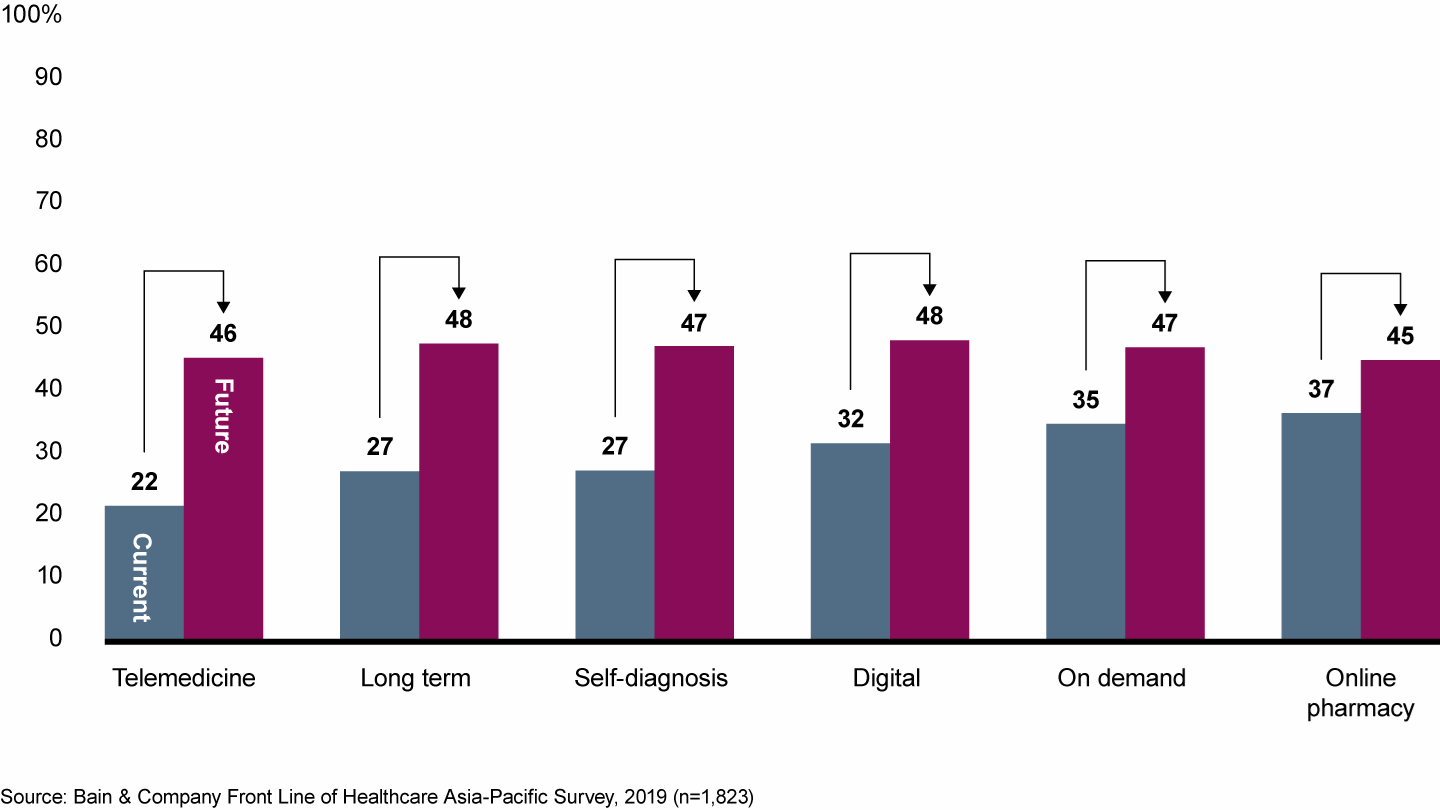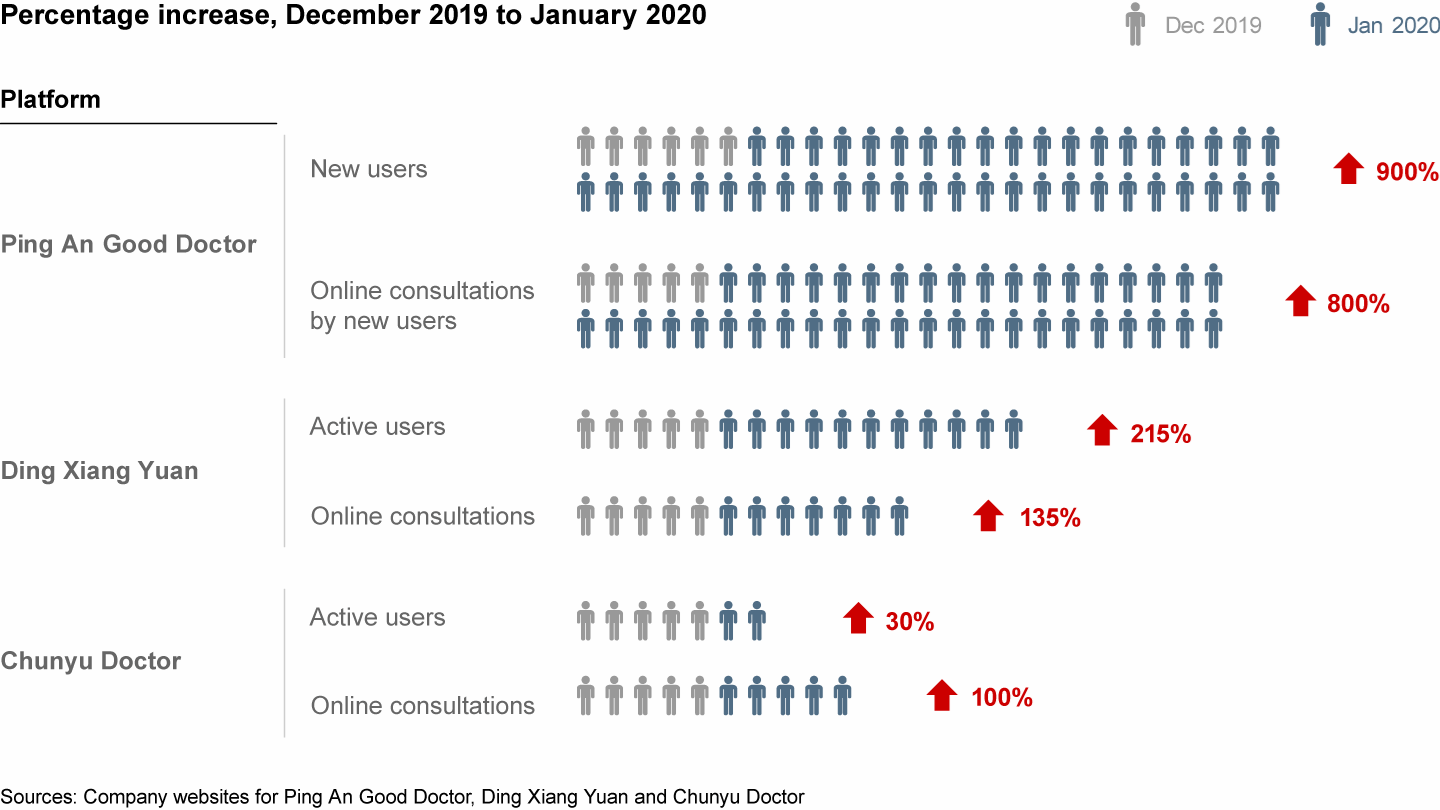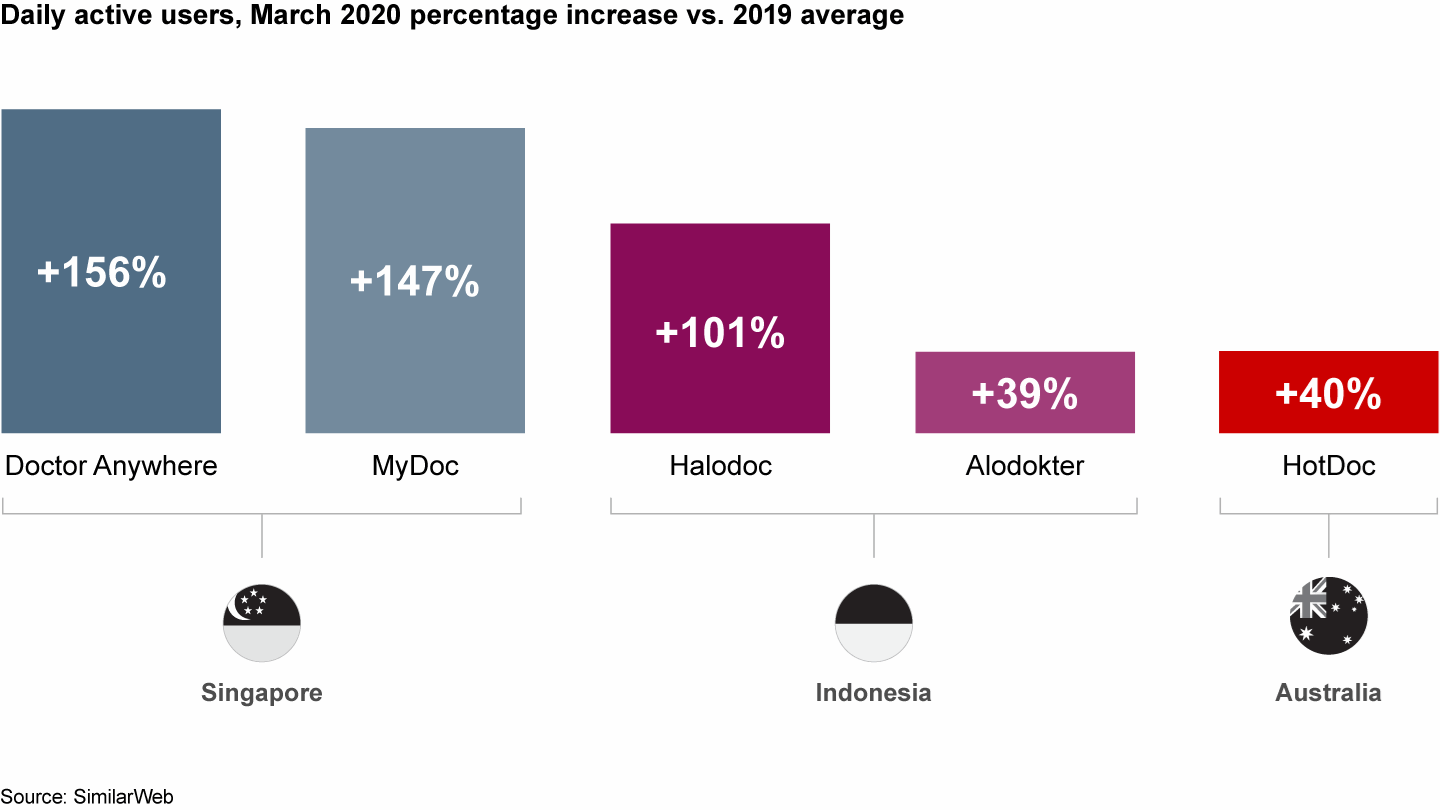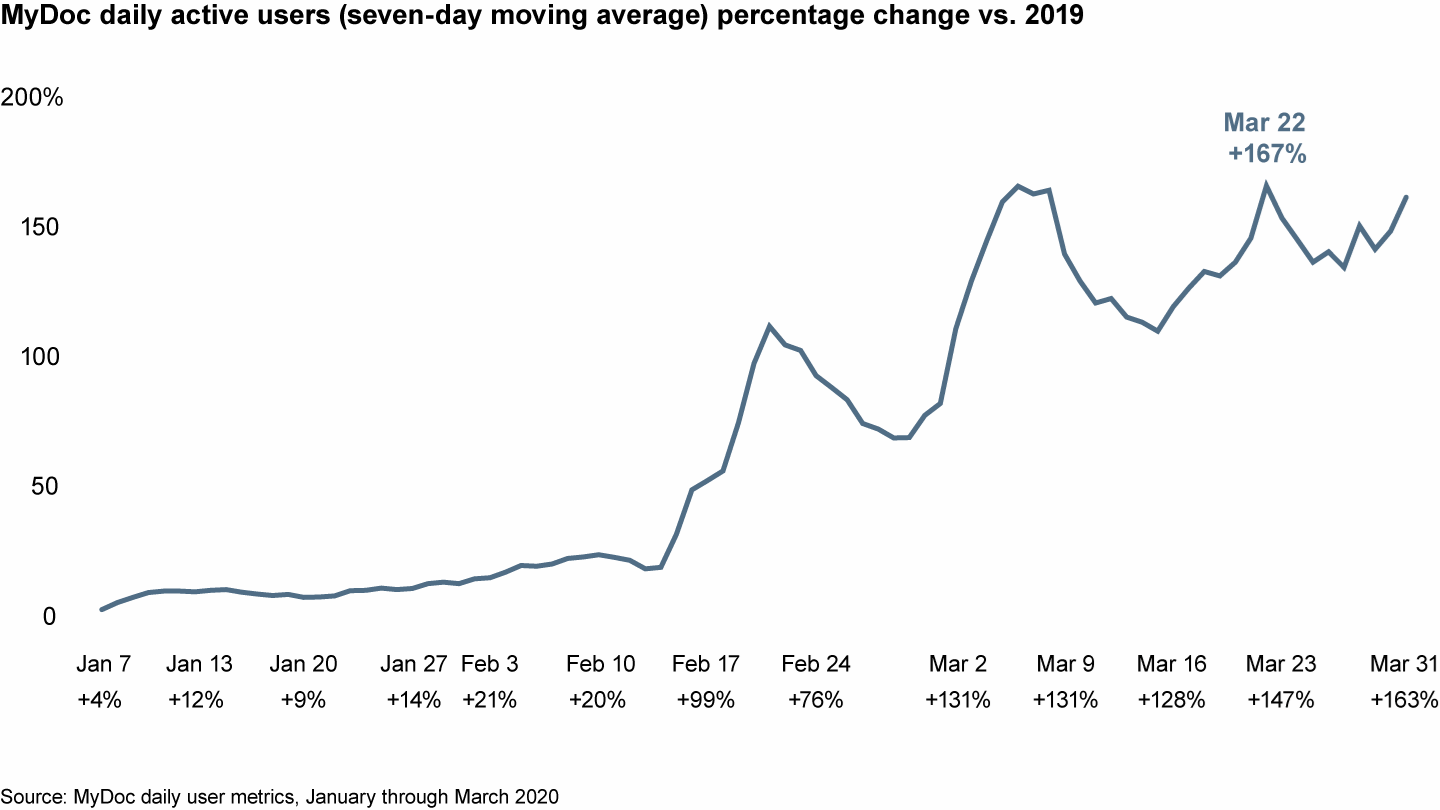Etude

When the Covid-19 outbreak began in China and spread throughout Asia, going for a regular doctor’s visit became risky or impossible. Stuck at home, many of those who needed to see a physician for other conditions turned to Internet-based options for diagnosis and treatment.
The crisis-related surge in the number of patients using telemedicine platforms and applications in the Asia-Pacific region is speeding the adoption of digital health tools. Already prior to the Covid-19 pandemic, telemedicine was nearing a turning point. Our research shows Asia-Pacific consumers are increasingly interested in preventative health, convenience and ownership of their care. In Bain’s 2019 Asia-Pacific Front Line of Healthcare survey, nearly 50% of patients said that they expect to use digital health tools in the next five years. And 91% of consumers said they would use digital health services if the costs were covered by an employer or insurance provider (see Figure 1).
Consumers expect to make greater use of digital health services in the next five years


The change that occurred over a period of weeks is dramatic. The number of new users on Ping An Good Doctor, a Chinese healthcare services platform, rose nearly 900% in January 2020, compared with December 2019, before the World Health Organization identified the virus. China’s Ding Xiang Yuan, an online community for healthcare professionals, and Chunyu Doctor, a telemedicine platform, also showed a sharp increase in online users and visits (see Figure 2).
Coronavirus has accelerated the growth of China’s online medical platforms


Digital health platforms in Singapore, Indonesia and Australia are reporting a surge of activity, too. At MyDoc, a telemedicine platform headquartered in Singapore, the number of daily active users rose 60% in February and more than doubled again in March (see Figures 3 & 4). As part of its response to the pandemic, the company set up a virtual Covid-19 clinic where doctors trained in detecting the virus evaluate patients’ symptoms and refer suspicious cases to the country’s Ministry of Health for testing and isolation.
The number of telemedicine users in Asia-Pacific rose sharply in the first months of 2020


Visits to Singapore’s MyDoc platform have risen more than 160% since the beginning of 2020


“What we are seeing is a step change in the acceptance of telemedicine,” says Snehal Patel, cofounder and CEO of MyDoc. “Having tracked users in this space for over seven years, this sort of rapid adoption is unprecedented.” Digital health tools are helping physicians treat patients from a safe distance while optimizing the capacity of the healthcare system during a surge in demand, he added.

Macro Surveillance Platform
For more detail on the business implications of coronavirus from Bain’s Macro Trends Group, log on to the Macro Surveillance Platform. Learn more about the platform >
Those benefits and the technology have been available for some time. But the Covid-19 outbreak removed the behavioral and economic barriers to widespread adoption of telemedicine.
Patient acceptance. Most people prefer to visit their physician in person. But amid the pandemic, virtual visits on telemedicine platforms have become the safe and convenient solution for a face-to-face medical consultation. Individuals worried about the risk of contracting Covid-19 at medical clinics, or confined to their homes, were able to gain access to medical advice and treatment without any risk of contracting the virus. Understanding the shifting market need, telemedicine providers offered free trials and partnered with other tech platforms to reach a wide base of the population.
Government support. Prior to the Covid-19 outbreak, Asia-Pacific governments were uncertain about the relative costs and benefits of supporting telemedicine on a broad scale. When the pandemic struck, the benefits of digital health platforms became overwhelmingly clear. Governments quickly made digital health platforms available to the general public as a tool to contain the spread of the virus. Australia extended Medicare coverage for telemedicine, South Korea eased restrictions on telemedicine to treat Covid-19 patients remotely, and Japan launched a free government-backed remote health service using digital health tools. Indonesia’s Ministry of Health partnered with ride-hailing giant Gojek and telemedicine provider Halodoc for quick Covid-19 diagnostics in remote areas.
Insurer acceptance. Health insurers were also cautious about the additional costs of covering telemedicine before the Covid-19 pandemic. In the midst of the ensuing public health crisis, many quickly added telemedicine services to standard policies. Multiple insurers across the region now have set up special partnerships with telemedicine platforms to sponsor free consultations.
Once having begun to use digital health platforms, patients are likely to continue using them, even after the pandemic subsides. Leading healthcare companies have begun to incorporate telemedicine services into their core offerings and improve care delivery. Here are the first steps to getting started.
Providers: Serve patients more effectively.
- Integrate offline and online care seamlessly to deliver better patient experiences and lower the cost of care.
- Use telemedicine and other digital healthcare tools for add-on services such as drug delivery, appointment scheduling, electronic records management and ongoing monitoring of conditions.
Payers: Improve plans and performance.
- Develop partnerships with digital insurgents to create differentiated healthcare plans, while lowering cost of care.
- Harness patient data and analytics to improve pricing and claims management
Regulators: Foster public health objectives.
- Encourage the adoption of telemedicine to improve access to healthcare and the quality of patient outcomes, allowing patients in remote areas with urgent care needs to see physicians rapidly.
- Take advantage of new services and data ecosystems in healthcare policy decisions.
As countries start to recover from the Covid-19 pandemic and retool, telemedicine will support a safe and staged recovery. It also lays the foundation for a new era of care delivery, helping countries improve the quality of care, hold the line on rising costs and do a better job of satisfying patient expectations.
Vikram Kapur is the leader of Bain & Company’s Healthcare practice in Asia-Pacific, and Alex Boulton is a partner with the Healthcare practice. They are based in Bain’s Singapore office.
The authors would like to thank MyDoc CEO and cofounder Snehal Patel for contributing valuable data and perspective to this article.

Coronavirus
The global Covid-19 pandemic has extracted a terrible human toll and spurred sweeping changes in the world economy. Across industries, executives have begun reassessing their strategies and repositioning their companies to thrive now and in the world beyond coronavirus.